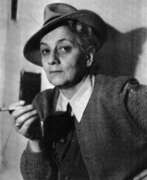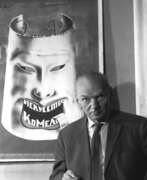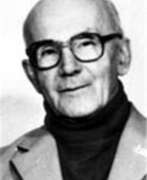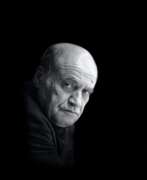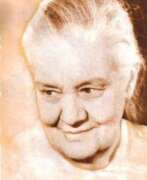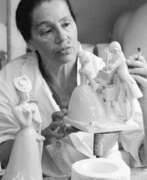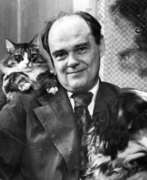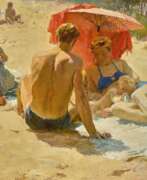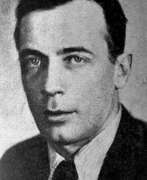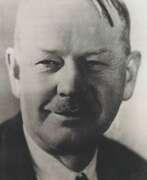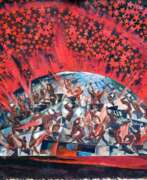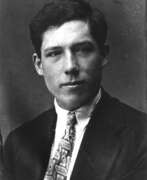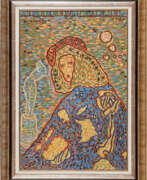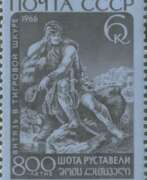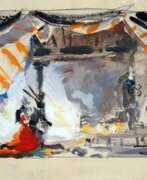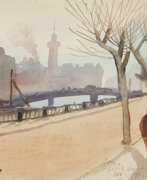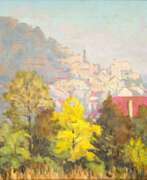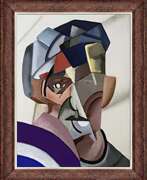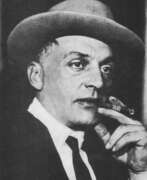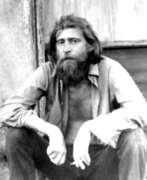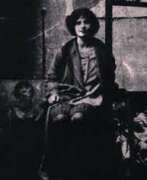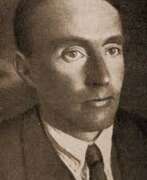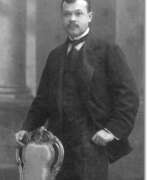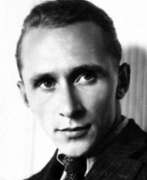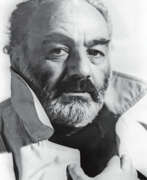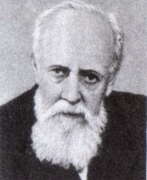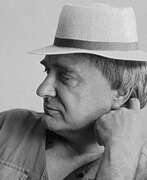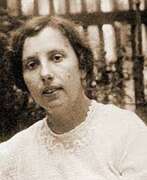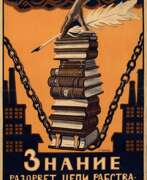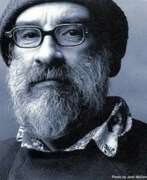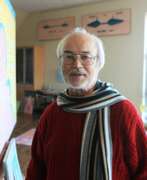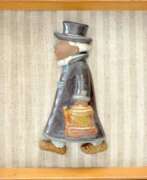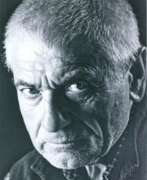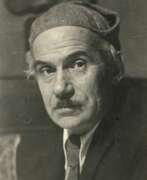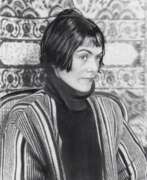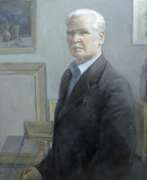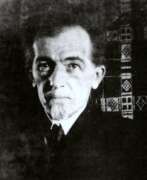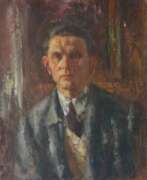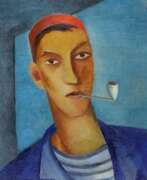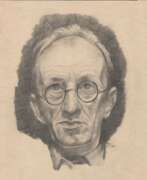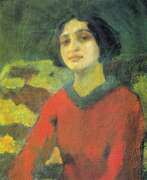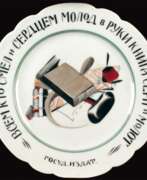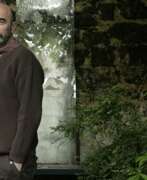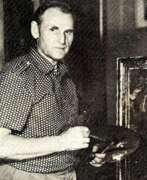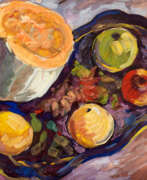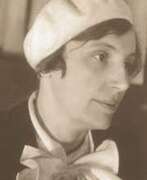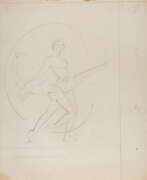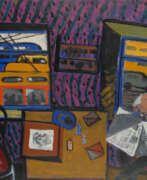Decorators USSR (1922-1991)
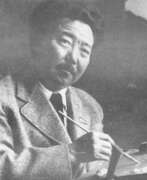

Gapar Aitievich Aitiev (Russian: Гапар Айтиевич Айтиев), a pioneering figure in Soviet Kyrgyz art, was born in 1912 and became a cornerstone of Kyrgyz cultural heritage through his impactful contributions as an artist and educator. Aitiev's journey in art began at the Moscow Art School in Memory of 1905, where he studied under N. P. Krymov between 1935 and 1938, laying the groundwork for his illustrious career. His profound connection to his Kyrgyz roots was reflected in his artwork, characterized by epic, poetic landscapes of Kyrgyzstan, such as "Midday on Issyk Kul" (1954), and detailed portraits like the "Gallery of portraits of contemporaries" (1979). Aitiev's contributions to the art world earned him the prestigious titles of People’s Artist of the USSR and Hero of Socialist Labor, marking his influence on Soviet and Kyrgyz art history.
The Gapar Aitiev Kyrgyz National Museum of Fine Arts, named in his honor, stands as a testament to his legacy, showcasing not only his work but also a broad spectrum of Kyrgyz and Russian art, spanning from traditional Kyrgyz artifacts to contemporary works post-independence. This museum, alongside the Gapar Aitiev Memorial Studio Museum in Bishkek, provides insight into Aitiev's life, offering a personal glance at his workspaces and the art that filled his surroundings. These institutions preserve and celebrate Aitiev's dedication to portraying the tranquil beauty of Kyrgyz landscapes and the spirit of its people, making his work an integral part of Kyrgyz national identity.
For those interested in the rich tapestry of Central Asian art, visiting these museums in Bishkek is a journey through the heart of Kyrgyz culture and history, brought alive by Aitiev's artistic vision. His work not only captures the essence of Kyrgyzstan's landscapes and people but also serves as a bridge between the traditional and the modern, embodying the nation's cultural evolution.
To stay updated on exhibitions and events celebrating Gapar Aitievich Aitiev's legacy and to explore more about his contributions to art and culture, consider signing up for updates. This subscription will keep you informed about new product sales and auction events dedicated to Aitiev's work, ensuring that enthusiasts and collectors alike remain connected to the vibrant world of Kyrgyz art.
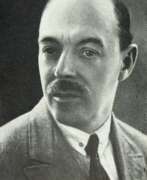

Anatoly Afanasyevich Arapov (Russian: Анатолий Афанасьевич Арапаов) was a Russian and Soviet artist, born in St. Petersburg in 1876 and passing away in Moscow in 1949. His artistic journey began after graduating from high school in 1892, leading him to study at the Moscow Boundary Institute where he initially acquired artistic skills. Arapov's dedication to art became undeniable, prompting him to enroll in the Moscow School of Painting, Sculpture and Architecture in 1897, where he was deeply involved in applied art, book design, and theater.
Arapov's early works, particularly around 1900 and 1910, were influenced by Symbolism, but he transitioned through a phase of Constructivism in the 1920s before dedicating himself to Socialist Realism from the 1930s onward. His versatile talent spanned across painting, graphic arts, and set design, making significant contributions to theater and film. Notably, he designed plays for leading theaters across major Russian cities and worked on popular films in the 1920s and 1930s.
His oeuvre includes portraits, still lifes, and landscapes, featuring views of ancient parks and Russian architecture. Arapov's works are celebrated for their stylistic diversity, capturing the essence of Symbolism, Constructivism, and Socialist Realism. His contributions are recognized in museum collections, including the State Tretyakov Gallery and the Saratov State Art Museum named after Radishchev, among others.
For collectors and art experts, Arapov's works offer a glimpse into the evolving art styles of early to mid-20th century Russia. To stay informed on sales and auction events featuring Anatoly Afanasyevich Arapov's art, signing up for updates can provide exclusive access to new discoveries and opportunities to acquire pieces by this multifaceted artist.
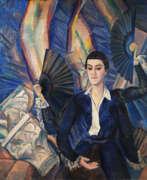

Elena Mikhailovna Bebutova (Russian: Елена Михайловна Бебутова) was a Russian and Soviet artist of the mid-twentieth century of Georgian-Armenian origin. She is known as a painter, graphic artist and scenographer.
Elena Bebutova evolved from a fascination with cubism and futurism in her early work to a more decorative and realistic style. In 1917, she began working on the decoration of performances in various theaters in Russia, and held a personal exhibition in Moscow in 1923. Returning to the USSR after business trips to Berlin and Paris, she became one of the founding members of the society "Four Arts". Her work in the theater was closely linked to the directing activities of her brother Valery Bebutova; their last collaboration was a production of Hamlet at the Vitebsk Belorussian Theater in 1946 and 1955.
Bebutova is also known as a model for portraits created by her husband Pavel Kuznetsov.
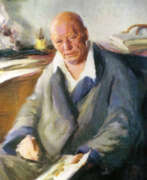

Pavel Petrovich Benkov (Russian: Павел Петрович Беньков) was a Russian and Soviet artist of the first half of the twentieth century. He is known as a painter, graphic artist, theater decorator, and teacher.
Pavel Benkov created portraits, landscapes, cityscapes, genre paintings. His style in his mature years can be described as impressionist, with attention to color and light. In 1929 he moved to Central Asia, where his style took on unique characteristics, reflecting local landscapes and culture. His work has had a significant influence on the painting traditions of Uzbekistan and Central Asia.
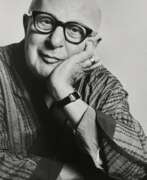

Eugène Berman was a Russian-born American painter and stage designer associated with the Surrealist and Neo-Romantic movements.
Eugene Berman's work often portrayed dreamlike landscapes, architectural structures and enigmatic figures. Berman was known for his meticulous attention to detail, rich colour palette and sense of theatricality in his compositions.
In his paintings, Berman created a world of poetic and mysterious atmosphere, evoking a sense of melancholy and introspection. His subjects often included mythological or allegorical figures, ruins and stage sets. His work had a surrealistic quality, mixing reality and imagination.
Eugène Berman also made a significant contribution to set design for theatre productions, particularly in collaboration with his wife, Leonora Carrington, a renowned surrealist painter. Their joint artistic vision brought surreal and fantastical elements to the stage, enhancing the overall theatrical impression.
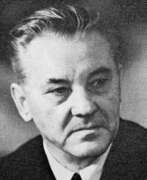

Georgy Nikolaevich Bibikov (Russian: Георгий Николаевич Бибиков) was a Russian and Soviet artist of the mid-20th century. He is known as a painter, graphic artist, illustrator, muralist and theater artist of the Leningrad school, working in the genres of landscape, portrait, still life and thematic painting.
Georgy Bibikov began participating in art exhibitions in 1920. Among his famous works are "Loaders", "Young Red Fleets Receive Uniforms", "Greetings to the Winners", "Trench Truth" and others. His works are in the State Russian Museum and in museums and private collections in Russia, Ukraine, Germany and France.
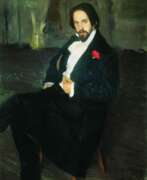

Ivan Yakovlevich Bilibin (Russian: Ива́н Я́ковлевич Били́бин) was a Russian illustrator, stage designer, and teacher, famed for his fairy tale illustrations and stage designs that drew heavily from Russian folklore and traditional art. Born in 1876 in St. Petersburg and passing away in 1942 during the Siege of Leningrad, Bilibin's career spanned a period of great change in Russia, from the pre-revolutionary times through to the Soviet era. His work is celebrated for its intricate detail, vibrant colors, and deep homage to Slavic myths and legends.
Bilibin's journey into the world of art and folklore began after his studies at the St. Petersburg University and the Munich art school. He was deeply influenced by Russian folklore, as well as modern French and Japanese art. This amalgamation of influences resulted in a unique style that made his work stand out. His illustrations for Russian folk tales, such as "The Frog Princess," "Vasilisa the Beautiful," and "Marya Morevna," are among his most celebrated works, encapsulating the essence of Russian narrative traditions.
Bilibin's career was not confined to illustration. He made significant contributions to the world of theater, designing sets for operas and ballets that further entrenched his reputation. His work took him beyond Russia, with periods spent in Egypt and France, where he continued to produce work for the Russian émigré and European communities. Despite the political turmoil of his time, Bilibin remained deeply connected to his roots, returning to Soviet Russia in 1936, where he continued his artistic and academic pursuits until his death in 1942.
For collectors and experts in art and antiques, Bilibin's works represent a bridge between the mystical past and the artistic innovations of the early 20th century. His legacy is preserved in museums and galleries worldwide, offering a glimpse into a world where folklore and art intertwine.
If you are keen to explore more about Ivan Yakovlevich Bilibin's remarkable contributions to art and folklore, consider signing up for updates. This subscription will keep you informed about new sales, auctions, and exhibitions related to Bilibin's work, ensuring you never miss an opportunity to engage with the magical worlds he created.
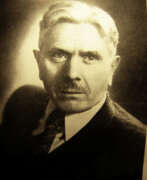

Mikhail Pavlovich Bobyshov (Russian: Михаил Павлович Бобышов) was a distinguished Soviet Russian painter, stage decorator, and professor, renowned for his contributions to the world of art. Born on November 7, 1885, in the Russian Empire and passing away on July 7, 1964, in the USSR, Bobyshov's artistic journey was marked by his affiliation with prestigious institutions and his recognition as a People's Artist of the Russian Federation. His work spanned various genres, including urban landscapes and portraits, demonstrating a unique style that blended realism with elements of impressionism, ornamentation, and decorationism.
Bobyshov's mastery in graphic art, particularly in book and magazine illustrations, as well as theatrical and decorative art, positioned him as one of the greatest masters of Soviet graphic art. His innovative approach to art was significantly influenced by the World of Art school, contributing to his legacy as a significant figure in the Leningrad School of Painting.
Among his notable works, "Evening in Moscow from the Series Victory Days in Moscow" stands out as an exemplar of his skill in capturing the essence of his subjects through gouache on paper. This piece, along with others, has been featured in prestigious auctions, highlighting Bobyshov's lasting impact on the art world.
For art collectors and experts, the work of Mikhail Pavlovich Bobyshov offers a rich tapestry of historical and cultural significance, encapsulating the essence of a pivotal era in Soviet art. His dedication to exploring and advancing the boundaries of artistic expression cements his status as a pivotal figure in the art community.
Stay updated on new product sales and auction events related to Mikhail Pavlovich Bobyshov by signing up for updates. This subscription ensures you're always informed about opportunities to engage with the enduring legacy of Bobyshov's art.
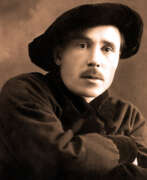

Alexei Nikolaevich Borisov (Russian: Алексей Николаевич Борисов) was a Russian and Soviet artist of the first half of the twentieth century. He is known as a painter, graphic artist, decorator, stage designer and teacher.
Alexei Borisov covered various themes in his work, from landscapes and portraits to works devoted to the partisan movement, industrialization and collectivization in Siberia, where the artist settled. His works, according to critics, stood out for their expressiveness, reverence, poetry and authenticity. The master left a significant creative legacy, including about 700 works of painting, graphics and decorative sketches.
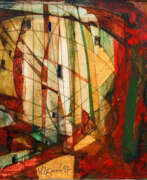

Ivan Ivanovich Chorny (Russian: Иван Иванович Чёрный) was a Soviet, Ukrainian and Russian artist of the second half of the twentieth and early twenty-first centuries. He was known for his monumental and decorative works in the style of socialist realism.
Ivan Chorny reoriented his style in the late 1990s, inventing a new technique and moving away from figurativeness in favor of abstract painting. His enigmatic compositions became an expressive expression of inner feelings enriched with colors and lines.
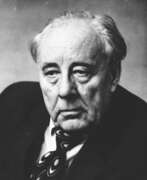

Mykhailo Hordiiovych Derehus (Russian: Михаил Гордеевич Дерегус) was a prominent Soviet Ukrainian graphic artist, painter, and educator, renowned for his significant contributions to the visual arts in Ukraine. Born on December 5, 1904, in Veseloye, Kharkiv Oblast, Derehus' artistic journey began at the Kharkiv Art Institute, where he not only honed his skills but also later imparted knowledge as a lecturer. His diverse body of work spans thematic painting, landscapes, still lifes, portraiture, etching, and book illustration, demonstrating his versatility across different mediums.
Derehus' art, particularly his expressionist lithographs, played a crucial role in illustrating significant Ukrainian literary works, such as Ivan Kotliarevsky's "Eneïda" and the writings of Nikolai Gogol, Lesya Ukrainka, Marko Vovchok, and Natan Rybak. His illustrations are celebrated for their depth and ability to capture the essence of the Ukrainian spirit. A testament to his mastery and significant impact on Ukrainian art, Derehus was awarded the prestigious Shevchenko National Prize in 1969. His legacy includes his leadership as Chairman of the National Union of Artists of Ukraine from 1955 to 1962 and his works being held in esteemed collections such as the Kuindzhi Art Museum in Mariupol, Ukraine.
For collectors and experts in art and antiques, Derehus' work represents a vital link in the chain of Ukrainian cultural heritage, offering unique insights into the nation's artistic evolution. His contributions have not only enriched Ukrainian visual arts but also ensured that the beauty of Ukraine's landscapes, its historical narratives, and the richness of its folklore continue to inspire future generations.
If you're intrigued by the artistic legacy of Mykhailo Derehus and wish to explore more about his works and their significance in the realm of Ukrainian art, consider signing up for updates. This subscription will keep you informed about new product sales and auction events related to Derehus, offering exclusive opportunities to connect with the rich tapestry of Ukrainian cultural expression.
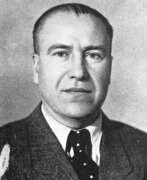

Aleksandr Aleksandrovich Deyneka (Russian: Алекса́ндр Алекса́ндрович Дейне́ка) was a Soviet Russian artist, celebrated for his significant contribution to the world of modernist figurative painting in the first half of the 20th century. Born into a Ukrainian origin, Deyneka's artistry spanned painting, graphic design, and sculpture, leaving an indelible mark on Russian modernism. His works, characterized by vivid movement and an innovative portrayal of the Soviet lifestyle, include iconic pieces such as "The Defense of Sevastopol," "Collective Farmer on a Bicycle," and "Future Pilots," which showcase the dynamism and spirit of the Soviet era. Deyneka's commitment to Social Realism—a style aimed at the accessible portrayal of everyday life—earned him both national and international acclaim. His murals and mosaics for public buildings and metro stations in Moscow, like the Mayakovskaya station, underline his influence on the Soviet visual landscape and contribute to his legacy as a pioneer of a style that bridged European innovation with Soviet themes.
Deyneka's journey began with his education at the VHUTEMAS, where he was influenced by figures such as Mayakovsky, which shaped his approach to art as a tool for societal influence and expression. His artworks, permeated with themes of labor, sports, and a forward-looking optimism, reflect the Soviet Union's utopian ambitions and the complexities of its societal structure. Notably, Deyneka's "Mother" stands out as a powerful symbol of the Soviet woman, intertwining high social awareness with the natural role of motherhood, highlighting the artist's nuanced approach to depicting Soviet life.
Throughout his career, Deyneka remained a formidable figure in art, navigating through various artistic societies and contributing to magazines and posters that defined the visual narrative of the Soviet Union. His travels to Italy, France, and the US broadened his perspective, enriching his work with international influences while retaining his distinct stylistic identity. Deyneka's decorations for the Moscow Metro not only won prestigious awards but also immortalized his vision of Soviet progress and optimism, capturing the essence of an era poised between grand aspirations and complex realities.
For art collectors and enthusiasts of Russian modernism, Deyneka's works offer a window into the vibrancy and ideological fervor of the Soviet Union, embodying the era's aesthetic and thematic aspirations. His contributions to the public and artistic spheres underscore the role of art in shaping and reflecting societal values, making his oeuvre a vital point of study for anyone interested in the intersections of art, history, and society.
To stay informed about exhibitions and auctions featuring Aleksandr Aleksandrovich Deyneka's work, sign up for updates. This subscription ensures you're always in the know about new sales and events related to this iconic artist, allowing you to deepen your appreciation and possibly enhance your collection.
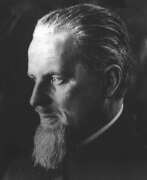

Ivan Semyonovich Efimov (Russian: Иван Семёнович Ефимов) was a Russian and Soviet artist of the first half of the twentieth century. He is known as an animal painter, graphic artist, sculptor, illustrator and reformer of the puppet theater.
Ivan Efimov worked in different genres and techniques, but all his work, including decorative and applied art, was focused on animalistic themes. He created works for the Moscow subway, train stations, sanatoriums and many other places and became famous for his technique of through volume relief in sculpture. The master also illustrated more than 20 books.
Efimov also created erotic works - about a thousand sheets with various thematic series, but the public learned about them only after the collapse of the USSR.
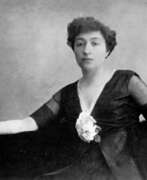

Aleksandra Aleksandrovna Ekster (Russian: Алекса́ндра Алекса́ндровна Эксте́р), a luminary of the Russian avant-garde, was a painter and designer whose work traversed the boundaries of Cubo-Futurism, Suprematism, and Constructivism, eventually influencing the Art Deco movement. Born in Białystok (then part of the Russian Empire, now Poland) and later splitting her life among Kiev, St. Petersburg, Moscow, Vienna, and Paris, Ekster played a pivotal role in bridging Russian and European artistic movements. Her innovative approach to art was characterized by dynamic movement, vibrant color contrasts, and geometric compositions, which were evident in her paintings, theater set and costume designs, and educational endeavors.
Ekster's studio became a hub for the intellectual and artistic elite, hosting figures like poets Anna Akhmatova and Osip Mandelstam, as well as painters Pablo Picasso and Georges Braque during her stays in Paris. Her involvement in significant art exhibitions, such as the Salon des Indépendants and the Salon de la Section d'Or in Paris, showcased her works alongside those of Jean Metzinger, Marcel Duchamp, and others, marking her as a key figure in the avant-garde community.
Beyond painting, Ekster's contributions to theater and design were profound. She worked on costume and set designs for Alexander Tairov's Chamber Theatre and participated in the revolutionary festivities' decoration in Kiev and Odessa. Ekster's pedagogical efforts included teaching at the Higher Artistic-Technical Workshop (VKhUTEMAS) in Moscow, fostering a new generation of avant-garde artists.
Ekster's work is housed in various international and private collections, reflecting her lasting impact on the art world. Her ability to integrate different genres and styles, along with her commitment to experimentation and innovation, made her one of the most influential women in the Russian avant-garde.
For those fascinated by the pioneering spirit of Aleksandra Aleksandrovna Ekster and the avant-garde movement, signing up for updates on new product sales and auction events related to her work is a compelling way to stay informed. This subscription ensures enthusiasts and collectors are always in the loop regarding opportunities to engage with Ekster's enduring legacy.
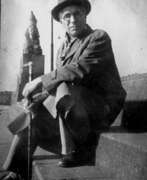

Rudolf Rudolfovich Frentz (Russian: Рудо́льф Рудо́льфович Фре́нц) was a Soviet and Russian painter, watercolorist, graphic artist, and art teacher, known for his contributions to the Leningrad School of Painting. Born on July 23, 1888, in Marienburg, a suburb of Saint Petersburg, he studied at the Imperial Academy of Arts under Vasily Savinsky and Nikolai Samokish. Frentz's early work focused on battle scenes, which became a hallmark of his style.
Frentz's work is celebrated for its dynamic composition and attention to historical detail, particularly in his depictions of military scenes. He was a member of the Leningrad Union of Artists and was deeply involved in the artistic community of Leningrad. His paintings, which often portrayed the heroism and struggles of Soviet soldiers, were exhibited in numerous prestigious shows and galleries throughout his career.
Notable works by Frentz include paintings like "Battle of Borodino" and "Storming of the Winter Palace," which are admired for their dramatic intensity and historical accuracy. His legacy continues to be honored in Russian art history, with his works held in collections such as the State Russian Museum and the Tretyakov Gallery.
Stay updated on new product sales and auction events related to Rudolf Rudolfovich Frentz by signing up for our updates. This subscription will only notify you of relevant sales and events.
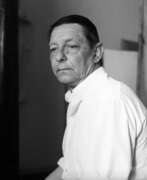

Anatoly Andreevich Gorpenko (Russian: Анатолий Андреевич Горпенко) was a Soviet artist of the mid-twentieth century. He is known as a painter and graphic artist, battle painter and portraitist.
Anatoly Gorpenko served as a war artist during the Great Patriotic War, creating propaganda posters and front sketches. His oeuvre includes pictorial works, including battle scenes and portraits of military figures. He also participated in the creation of dioramas and panoramas, and his works, including stained glass windows and mosaics, decorated monuments and buildings, including in Berlin.
Gorpenko also did graphics for publishers and magazines and created political posters.
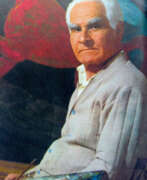

Lado Gudiashvili (Russian: Ладо Давидович Гудиашвили) was a Georgian artist, celebrated for his distinctive and innovative contributions to 20th-century art. Born in Tbilisi, Gudiashvili embarked on his artistic journey at the Tbilisi school of sculpture and fine art, later enhancing his skills in Paris's Ronson's private academy. His work, deeply influenced by Georgian life and culture, masterfully blends dramatic grotesque with poetic mystery, often incorporating elements of Caucasian and Persian traditions.
Gudiashvili's artistic repertoire was vast, encompassing painting, book design, graphic art, and teaching. He was an integral part of the Tbilisi Modernism and Socialist Realism periods, contributing significantly over a 60-year career. His engagement with avant-garde circles in Tbilisi and his murals for popular cafes showcased his versatility and creativity. Gudiashvili's Paris years (1919-1926) were marked by independence and recognition, as he exhibited alongside notable contemporaries and was encouraged to showcase his work independently.
His contributions were not limited to canvas; Gudiashvili also left an indelible mark on set design and book illustration, working on productions and literary classics that remain influential. Notably, his works adorn the Kashveti Church in Tbilisi, a testament to his monumental talent. Despite facing challenges, including political pushback for his church paintings, Gudiashvili's legacy as a pioneering Georgian artist remains undisputed. He received several high Soviet honors, underscoring his significance in the art world.
For collectors and experts in art and antiques, Gudiashvili represents a vital link between Georgian cultural heritage and modernist expressions. His works, which include engaging illustrations, set designs, and captivating paintings, continue to attract interest for their historical significance and artistic value.
To stay updated on sales and auction events featuring Gudiashvili's works, sign up for updates. This subscription will ensure you're informed about opportunities to acquire pieces by this remarkable Georgian artist.


Emma Ilyinichna Gurovich (Russian: Эмма Ильинична Гурович) was a Russian artist, born in 1899 and known for her contributions to painting. Throughout her lifetime, Gurovich actively participated in the art community, leaving behind a legacy that continues to be studied and appreciated. She passed away in 1980, but her work remains influential, showcasing her unique vision and artistic exploration.
Gurovich's artistic journey is marked by her involvement with the Union of Artists of the USSR, a prestigious recognition that underscores her significant role in the Soviet art scene. Her creations, primarily paintings, reflect a deep engagement with the artistic movements of her time, imbued with the historical and cultural context of the Russian Federation.
Her artworks, some of which have found their way into auctions, continue to attract attention from collectors and art enthusiasts alike. The sale of her works at auction highlights the enduring value and interest in her artistic contributions. Despite the limited availability of detailed biographical information, the auction records of Emma Iljinitschna Gurovich's works provide insight into her recognition in the art market and the lasting appeal of her artistic legacy.
For collectors and experts in art and antiques, the exploration of Emma Ilyinichna Gurovich's work offers a fascinating glimpse into the vibrancy of Russian art during her lifetime. Her contributions to the art world, marked by her unique perspective and dedication, continue to inspire and intrigue. To stay updated on new discoveries, sales, and auction events related to Emma Ilyinichna Gurovich's work, consider signing up for updates. This subscription ensures you won't miss out on the opportunity to engage with the ongoing legacy of this remarkable artist.
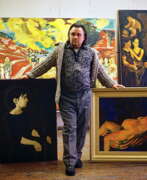

Alexander Mikhailovich Kishchenko (Russian: Александр Михайлович Кищенко) was a Soviet and Belarusian artist of the second half of the twentieth century. He is best known as a muralist painter.
Alexander Kishchenko is considered one of the most famous artists of Belarus of the 20th century, and his works are valuable assets of Belarusian culture. He worked in all genres of easel and monumental decorative painting and created hundreds of works during his career, including philosophical paintings and portraits. The artist was also proficient in mosaics, ceramics and tapestry.
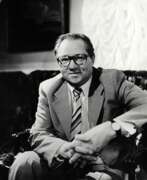

Yuri Konstantinovich Korolyov (Russian: Ю́рий Константи́нович Королёв) was a distinguished Soviet painter, monumental artist, and educator, renowned for his contributions to the art world. Born in 1929 and passing in 1992, Korolyov's career was marked by a profound dedication to the exploration of monumental and decorative compositions, painting, mosaics, and stained glass. His notable achievements include being honored as the People's Artist of the USSR in 1985 and serving as a corresponding member of the Academy of Arts of the USSR since 1983. Korolyov's influence extended beyond his artwork, as he was an esteemed professor at the Higher School of Industrial Art, where he shaped the minds of future artists, and notably held the position of Director at the Tretyakov Gallery from 1980 to 1992.
Korolyov's works are celebrated for their intricate detailing and profound thematic depth, capturing the essence of Soviet ideology through art. His masterpiece, "50 years of the USSR" in Tolyatti, created in 1981, stands as a testament to his skill in creating monumental art that resonates with historical significance and artistic beauty. This piece, among others, showcases Korolyov's mastery in blending artistic innovation with national pride, making his contributions invaluable to the Soviet art scene and beyond.
For art collectors and enthusiasts keen on exploring the works of a visionary who played a pivotal role in Soviet art history, Yuri Konstantinovich Korolyov's legacy offers a rich tapestry of cultural and artistic significance. His dedication to art education and his monumental contributions to the USSR's artistic heritage underscore the profound impact he had on the art world.
To stay updated on exhibitions and sales related to Yuri Konstantinovich Korolyov, signing up for updates is highly recommended. This subscription ensures that collectors and experts are informed about new opportunities to engage with Korolyov's enduring legacy, including upcoming auctions and events.
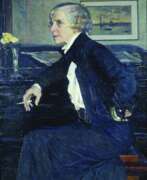

Elizaveta Sergeyevna Kruglikova (Russian: Елизавета Сергеевна Кругликова) was a Russian-Soviet artist, celebrated for her distinctive contributions to etching, silhouette art, and monotyping. Born into a St. Petersburg family with a deep appreciation for art, Kruglikova's talent blossomed early, supported by the artistic atmosphere at home. She honed her skills at the Moscow School of Painting, Sculpture and Architecture before moving to Paris, where she immersed herself in the city's vibrant art scene. From 1902, she experimented with etching, eventually becoming a notable figure in this field.
Kruglikova's Parisian period was marked by her work at the Académie de La Palette, where she both studied and taught, making significant contributions to the art of etching. Her return to Russia at the onset of World War I marked a new phase in her career, as she began exploring the realm of silhouette art, creating evocative portraits and scenes that captured the spirit of her subjects with striking clarity.
Perhaps most renowned for her pioneering work in monotype, a printing technique that allowed her unique expressivity, Kruglikova's art straddles the line between printmaking and painting. Her creations, ranging from the depiction of Parisian life to the vibrancy of the Russian cultural milieu, reflect a deep engagement with both her subjects and her mediums. The artist's ability to revive and innovate within traditional etching and printing techniques garnered her recognition and admiration, culminating in the dedication of the Fourth International Festival of Monotypes to her legacy.
Her works, characterized by a deep exploration of silhouette and monotype techniques, resonate with collectors and art enthusiasts to this day. Notably, Kruglikova was among the first Russian female artists to establish a studio in Paris, contributing significantly to the art scene there and back in Russia. Her late works include insightful portraits of fellow artists and poets, showcasing her mastery of silhouette style and positioning her as a key figure in the transition between printed graphic art and painting.
For collectors and experts in art and antiques, Kruglikova's legacy offers a fascinating glimpse into the innovative spirit of early 20th-century Russian and Soviet art. Her works not only reflect the artistic movements of her time but also stand as testaments to her individual creativity and technical prowess.
Stay informed about new sales, auction events, and exhibitions featuring Elizaveta Sergeyevna Kruglikova by signing up for updates. This subscription is your gateway to the world of a visionary artist whose work continues to inspire and captivate.
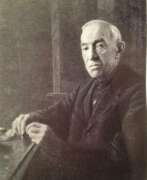

Nikolaу Petrovich Krymov (Russian: Никола́й Петро́вич Кры́мов), born on May 2, 1884, in Moscow, Russia, was a renowned Russian and Soviet painter and art theoretician, celebrated for his contributions to landscape painting and art education. Krymov hailed from an artistic family, and his education in the arts was comprehensive, studying under prominent figures like Abram Arkhipov, Nikolay Kasatkin, Leonid Pasternak, Valentin Serov, and Konstantin Korovin at the Moscow School of Painting, Sculpture and Architecture. His artistic journey began with participation in student exhibitions in 1906, and his works were soon featured in major exhibitions, including those of the Blue Rose, the Golden Fleece, and the Union of Russian Artists, marking his integration into significant artistic circles of his time.
Krymov's early works were significantly influenced by Isaac Levitan's delicate vision of Russian nature, focusing on the subtleties of daily transitions and the beauty of the Russian countryside. This influence is evident in Krymov's ability to convey the ethereal qualities of light and atmosphere in his landscapes, which were appreciated for their emotional depth and technical prowess. Among his notable works are paintings like "Dawn" (1908), "On the Mill" (1915), "First Snow" (1917), and "Hot Day" (1920), all of which demonstrate his masterful handling of light, shadow, and composition to capture the essence of nature.
Krymov's career also included significant contributions to art education and theory. He was an active participant in the "Blue Rose" movement, where he explored symbolism and impressionism, later transitioning towards a more classical approach in his landscapes. This evolution in style reflected his continuous search for an ideal harmony between reality and fantasy in his works. His dedication to art was recognized with several honors, including the title of Honorary Art Worker of the Russian Federation and the prestigious Order of the Red Banner of Labour.
Krymov's legacy extends beyond his paintings to include his influence on future generations of artists through his teaching and theoretical writings. His works are housed in museums and private collections, where they continue to be celebrated for their contribution to the landscape genre and Russian art.
For art collectors and experts interested in the rich tapestry of Russian landscape painting, Krymov's works offer a window into the soul of Russian nature and the artistic movements of the early 20th century. To stay updated on new product sales and auction events related to Nikolay Petrovich Krymov, signing up for updates is highly recommended. This subscription ensures that enthusiasts and collectors alike are informed about opportunities to acquire pieces by this illustrious artist, celebrating his enduring influence on the world of art.
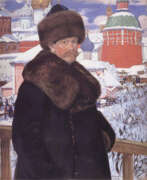

Boris Mikhailovich Kustodiev (Russian: Бори́с Миха́йлович Кусто́диев) was a distinguished Russian artist and painter, celebrated for his vivid portrayal of the Russian culture and way of life. Born in Astrakhan in 1878, Kustodiev's artistic journey began at a young age, leading him to study under the renowned Ilya Repin at the Imperial Academy of Arts. His works, characterized by their rich color palette and intricate detail, capture the essence of Russia's social and cultural fabric during the early 20th century.
Kustodiev's art is notable for its depiction of Russian peasantry, landscapes, and bourgeois celebrations, embodying the spirit and vibrancy of Russian folklore and traditions. His paintings such as "The Merchant's Wife" and "Maslenitsa" are celebrated for their lush visual storytelling and are housed in prestigious museums, including the State Russian Museum in St. Petersburg. These works reflect Kustodiev's fascination with the Russian merchant class and traditional festive gatherings, showcasing his skill in blending realism with a folkloric charm.
Beyond painting, Kustodiev's contributions to theatre and book illustration further demonstrate his versatile talent and deep connection to Russian cultural heritage. Despite facing personal challenges, including a debilitating illness that confined him to a wheelchair, Kustodiev's prolific output continued unabated, leaving behind a legacy that continues to enchant and inspire. His ability to capture the beauty and complexity of Russian life has made his work invaluable to collectors and experts in art and antiques alike.
For those intrigued by the rich tapestry of Russian culture and history as depicted through the lens of one of its most celebrated artists, we invite you to sign up for updates. Stay informed on new product sales and auction events related to the illustrious works of Boris Mikhailovich Kustodiev. This subscription is your gateway to the vibrant world of Russian art, offering exclusive insights and opportunities for collectors and enthusiasts.
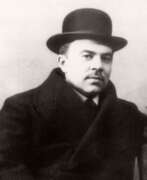

Pavel Kuznetsov (Russian: Павел Варфоломеевич Кузнецов) was a Russian artist, celebrated for his pioneering role in the Symbolist movement and his profound influence on the development of Russian modernist art. Born into the late 19th century, Kuznetsov's work spans painting, sculpture, and illustration, showcasing a unique blend of Eastern and Western artistic traditions.
Kuznetsov's art is renowned for its vibrant use of color, ethereal landscapes, and mystical themes. His distinctive style combines traditional Russian iconography with the innovative techniques of European modernism, making his work highly prized among collectors and art enthusiasts. Kuznetsov was a key member of the Blue Rose artist group, which sought to express the spiritual and emotional through art. This collective's contributions are considered seminal in the evolution of Russian Symbolism.
Among Kuznetsov's notable works are his dreamlike paintings of Central Asia, which brought a new dimension to Russian art by introducing themes and aesthetics from Eastern cultures. These pieces are not only significant for their artistic merit but also for how they reflect the cross-cultural exchanges of the early 20th century. Some of his masterpieces are held in prestigious institutions, including the Tretyakov Gallery and the Russian Museum, making them accessible to the public and subject to scholarly study.
For collectors and experts in the fields of art and antiques, Kuznetsov's works represent a valuable intersection of cultural heritage and artistic innovation. His contributions to the Symbolist movement and Russian modernism continue to inspire and influence contemporary art discourse.
To stay informed about new product sales and auction events related to Pavel Kuznetsov, sign up for our updates. This subscription is an excellent resource for collectors looking to enhance their collections with pieces by this distinguished artist. Join our community today and ensure you never miss an opportunity to acquire works by Pavel Kuznetsov.


Sergey Vasilyevich Malyutin (Russian: Сергей Васильевич Малютин) was a distinguished Russian painter, architect, and designer, celebrated for his multifaceted contributions to the world of art and design. Born in Moscow in 1859 to a merchant family, Malyutin's artistic journey began after an exhibition by the Peredvizhniki inspired him to pursue art. His formal education at the Moscow School of Painting, Sculpture and Architecture honed his talents, leading to a diverse career that spanned painting, set design for operas and ballets, and architectural endeavors.
Malyutin is perhaps best known internationally for designing the first matryoshka doll in 1890, a seminal work that has become an iconic symbol of Russian culture. His involvement in the Arts and Crafts Movement influenced his work, integrating traditional Russian folk motifs into his designs and paintings. Notably, his architectural designs, including the Church of the Holy Spirit in Talashkino and the Pertsov House in Moscow, showcase his dedication to the Russian Revival movement, blending fantastic folk motifs with architectural creativity.
Throughout his career, Malyutin also played a significant role in education, teaching at the Moscow School of Painting, Sculpture and Architecture and advocating for Socialist Realism. His contributions to Russian art were not limited to his creations; he was instrumental in founding the Association of Artists of Revolutionary Russia, emphasizing the importance of art in societal development.
For those interested in exploring the legacy of Sergey Malyutin, his works offer a window into the fusion of traditional Russian art with the innovative currents of his time. Collectors and experts in art and antiques will find his contributions to Russian arts and crafts, especially his role in the creation of the matryoshka doll, to be of particular interest.
To stay updated on exhibitions and auction events featuring Sergey Vasilyevich Malyutin's work, sign up for updates. This subscription is an invaluable resource for enthusiasts looking to deepen their understanding of Malyutin's impact on Russian art and design.


Lev Voldemarovich Nusberg, also Nussberg (Russian: Лев Вольдемарович Нусберг) is a Russian artist, architect and designer. He is considered one of the most important representatives of Russian Kinetic Art.
Nussberg studied architecture at the Moscow Institute of Civil Engineering and later at the Moscow University of Industrial Design. In the 1960s, he began to focus on kinetic artworks, which he described as "machines" that used movement and light to create a dynamic visual experience.
His works have been exhibited in many major museums and galleries around the world, including the Guggenheim Museum in New York, the Centre Georges Pompidou in Paris and the Tretyakov Gallery in Moscow.
Nusberg's work is known for its sophisticated technique and sense of humour. Many of his kinetic machines are interactive, encouraging viewers to interact with them and influence their movements and patterns.
In addition to his work as an artist, Nusberg also has a successful career as an architect and designer. He has been involved in the design of many important buildings in Moscow, including the Hotel Ukraina and the GUM shopping centre.
Overall, Nusberg has made a significant contribution to the Russian art and design scene and is now considered one of the country's most important artists.
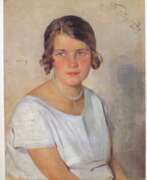

Mikhail Rodionovich Pestrikov (Russian: Михаил Родионович Пестриков) was a Russian and Soviet artist of the late 19th and the first third of the 20th centuries. He is known as a painter and teacher.
Mikhail Pestrikov was engaged in easel and monumental and decorative painting. He wrote portraits, created a number of paintings of biblical themes. The artist also carried out murals in houses, scientific institutions and churches.
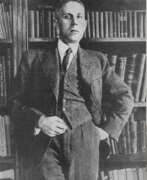

Anatoly Galaktionovich Petritsky (Russian: Анатолий Галактионович Петрицкий), a prominent Ukrainian and Soviet painter, graphic artist, theater artist, and teacher, was a master of the Ukrainian avant-garde who lived from 1895 to 1964. Born in Kiev, Petritsky was an influential figure in the Ukrainian art scene during the first half and mid-20th century. Despite the tragic loss of a large number of his graphic and pictorial works in a fire, his impact on the art world remains significant.
Petritsky's early career was marked by a vibrant engagement with the avant-garde movement. He studied at the Kiev Art School and later at the Moscow VKHUTEMAS, a hub for avant-garde art, under the guidance of A.D. Drevin and N.A. Udaltsova. His work from this period, including the painting "Invalids," exhibited at the 17th Venice Biennale in 1930, showcased his engagement with abstract paintings and constructive reliefs, highlighting the atrocities of war and reflecting on his dark childhood experiences.
Throughout the late 1920s and early 1930s, Petritsky's work diversified into painting, graphics, set design, illustration, and poster art, strongly influenced by Russian avant-garde styles. He created over 100-150 portraits, capturing not just the facial features but the essence and character of his subjects, including notable figures of the time.
Petritsky was awarded the title of People's Artist of the USSR in 1944 and won the Stalin Prize of the USSR twice, in 1949 and 1951, for his set designs. He taught at the Kiev Art Institute from 1946 to 1950, where he was a professor starting from 1947. His contributions to the art world are preserved in his memoirs, published in 1981, offering insights into his creative process and the artistic landscape of his time.
For collectors, experts in art, and antiques, the work and life of Anatoly Galaktionovich Petritsky offer a profound glimpse into the evolution of Soviet and Ukrainian avant-garde art. His legacy continues to inspire and influence contemporary art movements.
To stay updated on new discoveries, exhibitions, and auctions related to Anatoly Galaktionovich Petritsky's work, consider signing up for updates. This subscription will keep you informed about new product sales and auction events related to this key figure in the Ukrainian art of the 20th century.
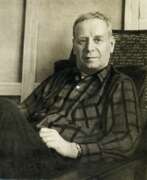

Yuri Ivanovich Pimenov (Russian: Юрий Иванович Пименов) was a distinguished Russian and Soviet painter, renowned for his pivotal role in the "lyrical Thaw" movement within Soviet art. Born in Moscow in 1903, Pimenov emerged as a vital figure in the realm of Soviet impressionism, a title he embraced despite the political and artistic shifts of his time. His unique blend of realism and impressionism, often termed "realistic impressionism," showcased his versatility and defiance against abandoning his creative principles.
Pimenov's journey in the arts was marked by his participation in the OST group and later the "Isobrigade," reflecting his adaptation and response to the evolving Soviet art scene. Despite facing challenges, including a significant psychological crisis in 1931, Pimenov's resilience and dedication to art remained unwavering. His works from this period, characterized by a rose-colored palette and an optimistic view of Moscow, highlight his evolution as an artist and his ability to portray the Soviet reality through a unique lens.
Among Pimenov's notable contributions to Soviet art are masterpieces like "Wedding on Tomorrow Street," "Lyrical Housewarming," and "Japanese Girl Kyoko," each reflecting various facets of Soviet life and Pimenov's personal experiences. These works, celebrated for their vibrant storytelling and intricate details, have solidified Pimenov's legacy as a master of Soviet impressionism.
Pimenov's influence extended beyond the canvas, as he engaged deeply with the world of theater and film, designing sets and posters that further showcased his artistic versatility. His travels abroad, particularly to Japan, enriched his perspective and influenced his later works, demonstrating his global appeal and the universal resonance of his art.
For art collectors and experts, Pimenov's oeuvre represents a unique investment in the history and evolution of Soviet art. His works, a blend of political narrative and personal expression, offer a profound insight into the era of the Soviet Union, making them invaluable pieces for any collection.
To stay updated on new product sales and auction events related to Yuri Ivanovich Pimenov, sign up for our updates. This subscription is your gateway to exploring the rich legacy and enduring impact of Pimenov's art on the Soviet and global art scenes.


Yakov Dorofeyevich Romas (Russian: Яков Дорофеевич Ромас) was a Russian artist renowned for his contributions to painting and decoration. Born in 1902 near Grodno, Romas had a rich educational background, having studied at the Prechistenka Technical Institute and the Artistic and Theatric Institute in Moscow. His education under notable artists like N.P. Krymov and P.P. Konchalovsky significantly influenced his artistic development. Romas was not only a participant in exhibitions since 1933 but also played a key role in the decoration of the Krasnoselskaya station of the Moscow subway. Beyond his contributions to public and architectural art, he served as a senior artist of the All-Union Agricultural Exhibition and tutored at the Surikov Moscow State Institute of Arts until his death in 1969 in Astrakhan.
Romas's life and work were deeply intertwined with the historical events of his time. He spent a significant portion of the WWII blockade on a cruiser, demonstrating remarkable bravery and skill. Notably, he trained about 150 Red Navy men and executed combat missions, earning him the Order of the Patriotic War of the II degree, the Order of the Red Star, and the medal “For the Defense of Leningrad”. His painting, “Winter Volleys of the Baltic,” created during this period, is celebrated for capturing the essence of the fleet's role in the war and stands as a testament to his artistic mastery and personal heroism.
Romas's works have been auctioned multiple times, fetching various prices and reflecting his enduring legacy in the art world. His piece titled “Northern Caspien” was auctioned for 2300 USD in 2006, indicating the continued interest and value of his work in the art market. His paintings are cherished not only for their historical significance but also for their artistic value, making them sought after by collectors and enthusiasts alike.
For those interested in exploring the profound work and legacy of Yakov Dorofeyevich Romas, signing up for updates is invaluable. By subscribing, you will receive alerts on new product sales and auction events related to Romas's artwork, ensuring you remain informed about opportunities to engage with and appreciate the contributions of this remarkable artist to Russian art and culture.
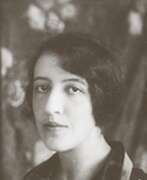

Tatiana Isidorovna Rusakova, née Kuperwasser, was a Soviet avant-garde artist and graphic artist.
Tatiana Rusakova studied at the Leningrad VKhUTEMAS-VKhUTEIN in the painting department under Kuzma Petrov-Vodkin and Osip Braz. In 1926-1932 she was an active member of the Circle of Artists association. Since 1946 - a member of the Union of Soviet Artists.
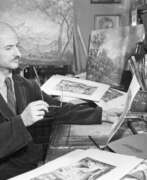

Vadim Fedorovich Ryndin (Russian: Вадим Фёдорович Рындин) was a Russian theater artist and a luminary in the Soviet art scene, celebrated for his transformative stage designs and costumes. Born in Moscow in 1902, Ryndin's journey into the world of theater art began after his studies at the Free Art and Technical Studios in Voronezh and at the Higher Art and Technical Studios (VKhUTEMAS) in Moscow. By 1931, he had become the principal artist at the Vakhtangov Theater, a role he expanded upon in 1953 when he took on the mantle of chief artist at the Bolshoi Theater of the USSR, significantly influencing its aesthetic and production values until 1970.
Ryndin's work was characterized by its heroic-romantic themes, a preference that emerged in the 1930s and remained a constant throughout his career. His knack for blending dramatic intensity with artistic minimalism was evident in productions like "The Optimistic Tragedy" and Shakespeare's "Much Ado About Nothing," where he used stark black-and-white color schemes and eschewed superfluous details to focus attention on the core narrative and emotional landscape of the performances.
His collaborations with directors, especially with N.P. Okhlopkov, led to groundbreaking renditions of classics such as "Hamlet," "Medea," and the opera "Mother." Ryndin's tenure at the Bolshoi Theater was marked by significant productions, including Prokofiev's "War and Peace," Verdi's "Don Carlos," and Rimsky-Korsakov's "The Legend of the Invisible City of Kitezh and the Maiden Fevronia," where his designs added depth and vibrancy to the visual storytelling.
Ryndin's profound understanding of art history allowed him to draw inspiration from past masters, ingeniously incorporating elements of El Greco's work into "Don Carlos" to enhance the production's tragic intensity. His approach to "The Legend of the City of Kitezh" showcased his ability to celebrate Russian cultural heritage through opulent stage designs and costumes that echoed the grandeur of Ancient Russia.
Despite the success and recognition he enjoyed, Vadim Ryndin remained a devoted artist to the end, continuously exploring and expressing the thematic and aesthetic potentials of theater art. His contributions have left an indelible mark on the Russian theater, making him a figure of immense respect and admiration in the art world.
For enthusiasts and collectors keen on exploring Vadim Fedorovich Ryndin's legacy and works, signing up for updates can provide exclusive insights into new sales and auction events featuring his artwork. This subscription is an opportunity to delve deeper into the artistic journey of a master whose work transcended the boundaries of stage design to become a pivotal part of Soviet cultural history.
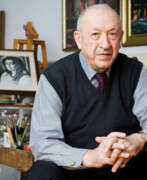

Tahir Salahov (Russian: Таир Теймурович Салахов) was an esteemed Soviet and Azerbaijani painter and draughtsman, celebrated for his pivotal role in the art world. Born in Baku, Azerbaijan, Salahov's journey into the arts commenced at the Azimzade Art College before advancing to the Surikov Moscow Art Institute. Early in his career, his work, particularly "The Shift is Over," garnered significant attention and acclaim, marking his prominence in the art scene.
Salahov's artistry is renowned for its embodiment of the "severe style," a movement within Soviet art in the 1960s that sought to provide a realistic, publicist view in contrast to the polished, idealized portrayal prevalent during the Stalin era. His masterpieces, notably portraits and scenes depicting the life of Baku oil workers, are lauded for their powerful expression and lack of idealization. Salahov's work underwent an evolution over the years, with his later pieces showcasing more peaceful, lyrical contemplations with evident Eastern influences, as seen in "Portrait of Grandson Dan." This transition is marked by smoother lines and a more sophisticated palette, highlighting his versatility and depth as an artist.
Salahov's contributions extended beyond his paintings; he was a key figure in several art academies and organizations worldwide, including the Artists' Union of the USSR and the Russian Academy of Arts. His achievements have been recognized with numerous awards, such as the People's Artist of the USSR and the Order "For Merit to the Fatherland." Salahov's legacy is cemented not only through his artworks but also through his significant impact on the cultural and artistic heritage of Azerbaijan and the broader Soviet and post-Soviet space.
For collectors and art enthusiasts, Salahov's work represents a crucial junction in the narrative of 20th-century art, bridging the gap between realism and the thematic, stylistic diversities of Soviet and Azerbaijani art. His paintings and drawings, many of which reside in prestigious museums, continue to inspire and captivate audiences worldwide.
If you're keen on exploring the life and works of Tahir Salahov further, consider signing up for updates. Subscribers will be alerted to new product sales and auction events related to Salahov's art, ensuring you stay informed about opportunities to engage with the legacy of this monumental artist.
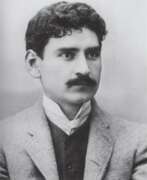

Martiros Saryan (Russian: Мартирос Сергеевич Сарьян), an Armenian painter, left an indelible mark on the art world with his vibrant landscapes, still lifes, and portraits that radiate the essence of Armenian culture and nature. Born in Nakhichevan-on-Don in 1880, Saryan's journey into the world of art was influenced by his studies at the Moscow School of Arts and notable artists like Paul Gauguin and Henri Matisse. His work is celebrated for its bright, bold use of color and a unique ability to capture the beauty of the Armenian landscape.
Saryan's artistic odyssey was marked by extensive travels across Turkey, Egypt, and Iran between 1910 and 1913, which enriched his palette and broadened his thematic scope. These experiences, coupled with his later contributions as a designer of the Armenian SSR's coat of arms and a theatre curtain, underscore his profound impact on Armenian national identity. Despite the challenges of the 1930s, Saryan's commitment to landscape and portrait painting never wavered, earning him prestigious awards and recognition within the USSR Art Academy and the Armenian Academy of Sciences.
Today, Saryan's legacy is preserved at the Martiros Saryan House Museum in Yerevan, where visitors can immerse themselves in his life and art. The museum showcases a wealth of his works, including renowned paintings like "Armenia" and "The Ararat Valley," offering a window into the culture and history of Armenia through Saryan's eyes.
For collectors and experts in art and antiques, the vibrancy and depth of Saryan's work offer a unique insight into Armenian heritage. Sign up for updates on new product sales and auction events related to Martiros Saryan, and explore the rich tapestry of Armenian art as seen through the masterful strokes of one of its greatest painters.
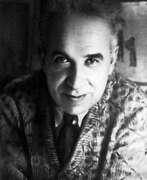

David Petrovich Shterenberg (Russian: Давид Петрович Штеренберг) was a Ukrainian-born Russian artist, recognized for his significant contributions to painting and graphic art. Born into a Jewish family in Zhitomir, Ukraine, Shterenberg's journey in art began in Odessa, leading him to Paris between 1906 and 1912, where he immersed himself in the vibrant artistic community. His studies at the Académie Vitti and interactions with notable artists like Kees van Dongen shaped his early artistic endeavors. Shterenberg's work, influenced by Paul Cézanne and Cubism, is celebrated for its expressive imagery, clear composition, and the strategic use of space.
Shterenberg's art evolved significantly over time, reflecting his deep engagement with the cultural shifts of his era. After returning to Russia post-1917 Revolution, he became an influential figure in Soviet art, leading the Department of Fine Arts at the People's Commissariat for Education and founding the Institute of Artistic Culture. Despite facing challenges under Soviet authority, which pushed him towards a more 'realistic' style, Shterenberg remained true to his unique artistic vision. His later years saw a return to themes of lyrical contemplation, notably in his Biblical Subjects series, completed before his death in 1948.
Today, Shterenberg's legacy lives on in major public galleries in Russia, including the Tretyakov Gallery, the Pushkin Museum, and the Russian Museum, as well as in private collections worldwide. His work encompasses a broad spectrum, from avant-garde experiments to intimate expressionist pieces, securing his place in the annals of modern art.
For enthusiasts and collectors alike, David Petrovich Shterenberg's oeuvre offers a rich exploration of early 20th-century art, marked by its innovative use of form and color, and its reflective engagement with the artist's cultural heritage and contemporary political landscape. Sign up for updates on new product sales and auction events related to Shterenberg, and discover more about this pivotal artist's contributions to the world of art.
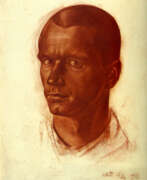

Vasily Ivanovich Shukhaev (Russian: Василий Иванович Шухаев) was a multifaceted Russian and Soviet artist, celebrated for his expertise as a painter, graphic artist, stage designer, and teacher. Born in Moscow in 1887, Shukhaev's artistic journey began at the Imperial Stroganov School of Industrial Art, where he was under the tutelage of prominent artists like K. A. Korovin and I. I. Nivinsky. His education continued at the St. Petersburg Academy of Arts, which paved the way for his diverse and influential career. Shukhaev's body of work is vast, encompassing hundreds of paintings, drawings, theater sketches, book illustrations, and monumental works, showcasing a deep engagement with genre paintings, still lifes, landscapes, and portraits.
Shukhaev's legacy includes a significant period of creativity and teaching in Paris in the early 20th century, after leaving Russia post-October Revolution. His Parisian phase was marked by innovative book illustrations for renowned literary works by Pushkin, Gogol, Dostoevsky, and others, demonstrating his unique ability to blend literary themes with visual artistry. Notably, his illustrations for Pushkin's "Queen of Spades" and "Boris Godunov" stood out for their stylistic nod to vintage prints and the emblematic use of symbols.
His art has been celebrated in various international exhibitions and is held in high regard by collectors and museums alike. Works such as "The Reigning Monarchs of the World" (1934), a group caricature published in Vanity Fair, reflect Shukhaev's versatile style and ability to capture the essence of his subjects with a mix of reverence and subtle critique.
For art collectors and enthusiasts interested in Russian and Soviet art, Vasily Ivanovich Shukhaev's oeuvre represents a bridge between classical traditions and modern artistic expressions. His work continues to captivate audiences with its historical depth, technical brilliance, and emotive power.
If you're keen on exploring more about Vasily Ivanovich Shukhaev's works or wish to stay updated on sales and auction events featuring his art, signing up for updates is a step towards immersing yourself in the rich tapestry of Russian art history.


Ivan Nikolayevich Shulga (Russian: Иван Николаевич Шульга) was a Ukrainian Russian and Soviet artist of the first half of the twentieth century. He is known as a master of painting and drawing and a teacher. His name is included in the "Unified Art Rating of the world's 10,000 best artists" and in the list of the 100 most outstanding artists of Ukraine.
Ivan Shulga worked in different genres: he painted portraits, genre paintings, landscapes (marine, landscape, architectural, industrial), created still life paintings, panels, drawings for art postcards, political posters. His artistic legacy also includes pictures in the genre of nude and historical genre. The artist also illustrated magazines and books, designed theatrical sets.
Shulga worked in watercolor, pencil drawing, gouache, ink and sanguine, pastel, oil and tempera painting.
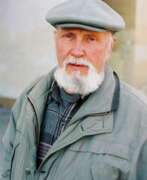

Vladimir Ivanovich Stelmashonok (Russian: Владимир Иванович Стельмашонок) was a Belarusian and Soviet artist of the second half of the twentieth and early twenty-first centuries. He is known as a painter, graphic artist and teacher.
Vladimir Stelmashonok worked in different genres and techniques. In easel painting he created mainly portraits - mainly of figures of history and culture of Belarus. In monumental and decorative art, the creative heritage of the artist includes a number of monumental works in Minsk, Ukraine and East Germany, including stained glass windows and mosaics for metro stations.
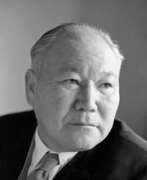

Ural Tansykbaevich Tansykbayev (Russian: Урал Тансыкбаевич Тансыкбаев) was a distinguished Uzbek painter of Kazakh descent, celebrated for his vivid and expressive works. Born on January 1, 1904, in Tashkent, Tansykbayev's artistic journey was profoundly influenced by Fauvism and French Expressionism, evident in his early work's increased decorativeness and vibrant use of color. His contributions to the Regionalist movement further defined his legacy, marking him as a pivotal figure in Uzbekistan's art history.
Throughout his career, Tansykbayev's art evolved, with a significant shift in the 1950s towards landscape painting, which became the main genre of his later works. His talent and contributions were recognized with numerous governmental awards, including the prestigious Order of Lenin and the Hamza State Prize of the Uzbek SSR in 1973. Tansykbayev's works are cherished globally and can be found in several museums, including the Ural Tansykbayev Memorial Museum in Tashkent, the State Tretyakov Gallery in Moscow, and the State Museum of Oriental Art, also in Moscow.
The Ural Tansykbayev Museum in Tashkent, established by his widow, Elizaveta Tansykbayeva, serves as a testament to his life and work. Opened in 1981, the museum houses not only his paintings but also the artist's studio, offering a personal glimpse into his creative world. This museum stands as a cultural landmark, celebrating the legacy of a man who significantly impacted Uzbek and Soviet art.
For collectors and art experts interested in Tansykbayev's profound and colorful works, signing up for updates on new product sales and auction events related to Ural Tansykbayev is highly recommended. This subscription ensures you stay informed about opportunities to own a piece of this legendary artist's legacy.
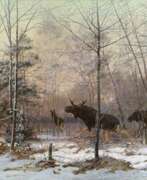

Evgeny Alexandrovich Tikhmenev (Russian: Евгений Александрович Тихменев) was a Russian artist, born in 1869 and passed away in 1934. Renowned for his depictions of natural scenes and hunting expeditions, his works encapsulate the essence of rural Russian life during his time. Tikhmenev's artwork, such as "Before the Hunt," captures moments of anticipation and interaction with nature, often featuring meticulous detail and vibrant settings.
His pieces are cherished in art circles for their historical value and their ability to convey the story of an era when hunting was not only a sport but a significant aspect of rural survival and culture. Notably, Tikhmenev's paintings have been sold at various auctions, with some pieces fetching substantial prices, highlighting their desirability among collectors and art enthusiasts.
For collectors and experts in art and antiques, Tikhmenev's works present a valuable investment, both culturally and financially. To stay updated on new sales and auction events featuring Evgeny Alexandrovich Tikhmenev’s work, signing up for timely updates is recommended, ensuring enthusiasts don't miss out on acquiring a piece of Russian art history.
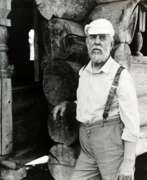

Andrei Vladimirovich Vasnetsov (Russian: Андре́й Влади́мирович Васнецов) was a prominent Russian painter, muralist, and a veteran of World War II. He was a key figure in the development of the "Severe Style" in Soviet art, which emerged as a significant movement during the mid-20th century. Vasnetsov's artistic heritage includes a diverse range of works including portraits, landscapes, still lifes, and monumental art such as frescoes and mosaics for public buildings across the USSR.
Born into a family of artists, Andrei was deeply influenced by his grandfather, Victor Vasnetsov, a celebrated master of historical painting. This familial legacy enriched his approach to art, combining traditional themes with a modernist vigor that defined his contributions to Russian art. Vasnetsov's education at the Moscow Institute of Applied Art and the Leningrad Higher School of Art and Industry further honed his skills, particularly in monumental painting.
His works are part of several prestigious collections, including the State Tretyakov Gallery and the Russian Museum, underscoring his significance in the Russian art scene. His commitment to art extended beyond creation; he was an influential mentor and educator, inspiring future generations of artists.
For art collectors and enthusiasts wishing to explore or acquire works by Andrei Vasnetsov, staying informed about upcoming auctions and private sales can be essential. Sign up to receive updates on new artwork sales and auction events featuring Vasnetsov's works, ensuring you never miss an opportunity to own a piece of this influential artist's legacy.
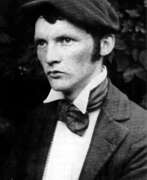

Heinrich Vogeler was a German artist and philosopher, a representative of the German Art Nouveau. A versatile and talented artist, he painted, watercolored, composed poems, designed, designed and decorated. Over time, his style of art changed over a wide range.
During World War I, from 1914 to 1917, Vogeler was on the Eastern Front as a volunteer and made sketches, which resulted in his pacifist sentiments.
In the mid-1920s he visited the Soviet Union several times and his impressions resulted in paintings in his own "complex style: "Karelia and Murmansk" (1926), "Building a New Life in the Soviet Republics of Central Asia" (1927), and "Baku" (1927). In 1931 Vogeler received an invitation to work in the USSR. The coming to power of the Nazis in Germany made it impossible for him to return home, and after Hitler's invasion Vogeler among many was deported to the Kazakh SSR, where he died.


Vsevolod Vladimirovich Voinov (Russian: Все́волод Влади́мирович Во́инов) was a prominent Russian artist, born in St. Petersburg in 1880 and passing away in 1945 in the same city. He is renowned for his contributions to the art of wood engraving, a skill that he mastered and innovated upon throughout his career. His works are notable for their depth and intricate detailing, showcasing a mastery of the medium that few of his contemporaries could match.
One of his well-known works, "Park outside the Russian Museum," created in 1923, is a wood engraving that reflects his ability to capture the essence of a scene with remarkable clarity and depth. This particular piece is part of The Metropolitan Museum of Art's collection, emphasizing the international recognition of Voinov's talent and the lasting impact of his contributions to the art world.
Voinov's influence extended beyond his own creations; he was instrumental in reviving woodcuts as an independent easel technique. His mentorship and encouragement played a crucial role in the development of other artists, notably influencing the works of D.I. Mitrokhin, among others. Voinov's dedication to the craft and his role in the artistic community highlight his importance not just as an artist, but as a key figure in the promotion and development of wood engraving.
Throughout his life, Voinov's artworks were celebrated for their unique style and contributions to Russian art, marking him as a significant figure in the early 20th century's artistic movements. Despite the limited number of his works that went up for auction, each piece reflects the high caliber of his skill and his dedication to his craft. His work continues to be sought after by collectors and art enthusiasts, demonstrating the enduring appeal and significance of his artistic legacy.
For those interested in the intricacies of Russian art and the evolution of wood engraving, Vsevolod Vladimirovich Voinov's works offer a fascinating study. His dedication to his craft and his influence on subsequent generations of artists make him a pivotal figure in the history of art. To stay updated on new discoveries, exhibitions, and sales related to Voinov's work, consider signing up for updates specifically tailored to his oeuvre. This ensures that collectors and experts alike remain informed about the latest developments and opportunities to engage with the rich legacy of Vsevolod Vladimirovich Voinov.
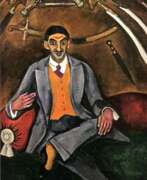

Georgy Bogdanovich Yakulov (Russian: Гео́ргий Богда́нович Яку́лов) was a multifaceted Armenian artist renowned for his contributions across several artistic domains, including painting, graphic art, stage design, and art theory. Born on January 16, 1884, in Tiflis (now Tbilisi), Yakulov's work is celebrated for its abstract art and avant-garde approach, blending Eastern influences with European modernism. His art is notable for its abstract qualities, rich decorative colors, and a unique blend of romantic expressionism with a fascination for Oriental exoticism.
Yakulov's journey into the art world was marked by significant milestones, such as his studies at the Moscow School of Painting, Sculpture and Architecture, and his military service in northeast China, which introduced him to Eastern light effects and decoration. His artistic career flourished with exhibitions across Moscow, Paris, and Berlin, where he became associated with notable movements and figures, including the Delaunays and their theory of Simultanism.
A pivotal moment in Yakulov's career was his contribution to theatre, most notably his work with the Moscow Chamber Theatre and his designs for ballets, including those commissioned by Diaghilev for the Ballets Russes. This period highlighted his ability to merge traditional theatrical techniques with modernist abstraction, creating a lasting impact on stage design.
His theories, particularly the "Theory of Colored Suns," showcased his innovative approach to art, emphasizing the importance of light and color, which he explored through his essays and designs. Despite his passing on December 28, 1928, Yakulov's legacy endures through his contributions to modern art and theatre, with works displayed in notable galleries and a special place among avant-garde artists.
For art collectors and enthusiasts interested in exploring the rich tapestry of Eastern and European avant-garde movements, Georgy Bogdanovich Yakulov's work represents a fascinating convergence of cultures and artistic philosophies. To stay updated on new discoveries and exhibitions related to Yakulov, consider signing up for updates. This will ensure you're always informed about sales and auction events celebrating his remarkable legacy.


Stepan Petrovich Yaremich (Russian: Степан Петрович Яремич) was a multifaceted Ukrainian artist and art historian, whose career spanned the late 19th and early 20th centuries. His profound contributions to art history and preservation, particularly during the tumultuous post-revolutionary period in Russia, underscore his significance beyond his work as a painter. Yaremich's expertise in Western European drawing, bolstered by his years in Paris where he amassed an impressive collection featuring masters like Watteau and Fragonard, highlighted his remarkable connoisseurship.
Educated in Kiev and Paris, Yaremich was associated with the "World of Art" movement and worked closely with figures like Alexandre Benois. He was not just an artist but a respected art expert, often involved in the restoration and cataloging of Russian and Western European art. His time at the Hermitage and Russian Museum showcased his dedication to art preservation, contributing significantly to the fields of art history and conservation.
Yaremich's artistic legacy includes landscapes of St. Petersburg, Venice, and other locales, characterized by a unique approach to color and form that distinguished his work from his contemporaries. Despite the critical acclaim, it was his behind-the-scenes work as an art historian and conservator that solidified his enduring impact on the art world.
Collectors and experts in art and antiques will find Yaremich's work both compelling and significant, underlining the importance of not only creating art but also preserving it for future generations. For updates related to Stepan Petrovich Yaremich, including sales and auction events, sign up for our newsletter. This subscription will keep you informed about the latest findings and opportunities to acquire works associated with this remarkable figure in art history.


Indulis Zariņš (Russian: Индулис Августович Зариньш) was a Latvian painter and educator, renowned for his mastery in tonal painting and as a significant figure in figurative painting. Born in Riga in 1929, Zariņš' art was profoundly influenced by historical and social themes, reflecting his deep engagement with the Latvian and Soviet cultural milieu. His education and early career were marked by challenges, including deportation with his family during World War II, but he emerged as a leading artist, completing his education at the Latvian Academy of Art under Eduards Kalniņš in 1958.
Zariņš was recognized for his contributions to art with several awards, including the Grekov Prize in 1968 and the title of People's Artist of the USSR in 1986. His political activism during the Latvian Awakening period is notable, as he transitioned from a critic of mass actions to a representative of the Latvian Popular Front, reflecting his complex relationship with the era's political dynamics.
His works, particularly those focusing on the Latvian Red Riflemen, combine Latvian national history with Soviet ideological demands, offering a nuanced exploration of identity and memory. Zariņš' ability to navigate these themes while drawing inspiration from Western European tonal painting traditions, like those of Diego Velázquez and Johannes Vermeer, highlights his skill in blending historical narratives with artistic innovation.
For collectors and experts in art and antiques, Zariņš' legacy is a testament to the rich cultural history of Latvia and the broader Soviet experience. His works not only adorn museums but also continue to influence contemporary understandings of Latvian art and history.
For updates related to Indulis Zariņš, including sales and auction events of his works, sign up for our newsletter. This subscription is your gateway to the latest in the world of art and antiques, connecting you directly to the legacy of Zariņš and beyond.
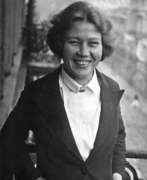

Maria Abramovna Zubreeva (Russian: Мария Абрамовна Зубреева) was a Soviet artist of the twentieth century. She is known as a painter, graphic artist, decorator, representative of the Leningrad school of painting, and one of the first members of the Leningrad Union of Artists. Her work encompassed a variety of genres, including portraits, landscapes, still lifes and genre compositions. She was engaged in both easel and monumental painting, interior decoration, and book illustration. The artist often worked in the technique of watercolor and tempera painting.
Maria Zubreeva, together with her husband, artist Sergey Zakharov, spent many years in Tajikistan, where she made a significant contribution to the art of this region. Her watercolor portraits and eastern landscapes remain the most interesting part of her artistic heritage.
